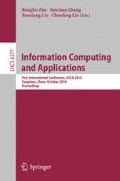Abstract
The finite element model for reinforced-concrete frame beam to resist progressive collapse was established by ADINA program, which geometrical and material non-linearity considered. Axial forces are often present in reinforced- concrete beam at the ultimate load as a result of the boundary conditions and geometry of deformation of the beam segments. So the ultimate load-carrying capacity of reinforced-concrete frame beam was increased because of the arching and cable action (compressive and tensile membrane action). The influence of the beam to resist progressive collapse has been discussed such as steel ratio, span-depth ratio. It shows that the finite element model presented is feasible and can be applied to further research on engineering practice for reinforced-concrete frame structure to resist progressive collapse.
Access this chapter
Tax calculation will be finalised at checkout
Purchases are for personal use only
Preview
Unable to display preview. Download preview PDF.
References
Minghui, C.: Experimental study on influence of reinforcement ratio on arching action of reinforced concrete frame beams, pp. 17–19. Hebei Polytechnic University, Hebei (2007)
Xiaosheng, S.: Experimental study on influence of span-thickness ratio on Arching action of reinforced concrete frame beams, pp. 37–41. Hebei Polytechnic University, Hebei (2009)
ADINA R&D.: ADINA Theory and Modeling Guide. Watertown, pp. 263–270 (2001)
Guice, L.K., Edward, J.: Rhomberg. Membrance Action in partially Restrained Slab. ACI Structural Jounrnal, 365–373 (2008)
Guice, L.K.: Effects of Edge Restraint on Slab Behavior. Technical Report No.86-2, U.S. Army Engineer Waterways Experiment Station, pp. 180–185 (1996)
Park, Robert, Gamble: Reinforced Concrete Slabs, pp. 575–578. John Wiley & Sons, New York (1990)
Author information
Authors and Affiliations
Editor information
Editors and Affiliations
Rights and permissions
Copyright information
© 2010 Springer-Verlag Berlin Heidelberg
About this paper
Cite this paper
Qi, J., Su, Y., Sun, Y., Ding, Y., Ma, L. (2010). Finite Element Simulation of Reinforce-concrete Frame Beam to Resist Progressive Collapse. In: Zhu, R., Zhang, Y., Liu, B., Liu, C. (eds) Information Computing and Applications. ICICA 2010. Lecture Notes in Computer Science, vol 6377. Springer, Berlin, Heidelberg. https://doi.org/10.1007/978-3-642-16167-4_59
Download citation
DOI: https://doi.org/10.1007/978-3-642-16167-4_59
Publisher Name: Springer, Berlin, Heidelberg
Print ISBN: 978-3-642-16166-7
Online ISBN: 978-3-642-16167-4
eBook Packages: Computer ScienceComputer Science (R0)

